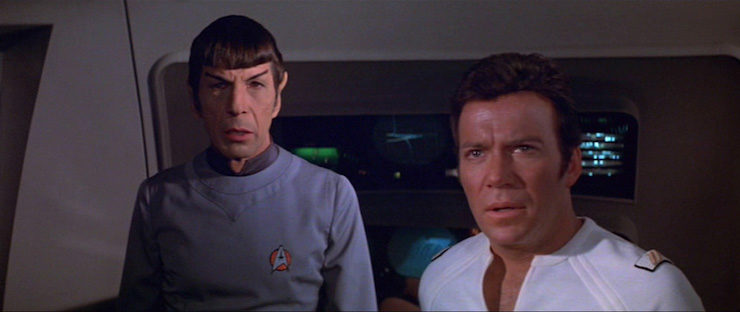Star Trek: The Motion Picture
Written by Alan Dean Foster and Harold Livingston
Directed by Robert Wise
Release date: December 7, 1979
Stardate: 7410.2
Captain’s log. Three Klingon ships approach a weird blue swirly thing. The Klingon captain orders torpedoes to be fired into the swirly thing, but they are ineffective, and the captain then orders evasive maneuvers. The swirly thing responds by vaporizing each Klingon ship, one by one.
Federation Station Epsilon 9 monitors the destruction of the Klingon ships, and also plots the swirly thing’s course: it’s en route directly to Earth.
On Vulcan, Spock (no longer in Starfleet) is undergoing Kolinahr, a ritual that purges all emotion from a Vulcan—and which also requires him to have a shaggy haircut and wear tan robes. He meets with three Vulcan elders who are about to place the symbol of logic around his neck, saying he has achieved Kolinahr, but Spock is distracted by something. One of the elders mind-melds with him, and learns that something is telepathically contacting him from space, awakening curiosity in his human half. He therefore cannot achieve Kolinahr, and they drop the necklace on the ground. Okay, then.
On Earth, Kirk (now an admiral) arrives at Starfleet Headquarters for a meeting with Admiral Nogura. He encounters Commander Sonak, the new science officer of the Enterprise, and is surprised he isn’t on board. Sonak points out that the ship won’t be leaving dock for another twenty hours, but Kirk says that it’ll be leaving in twelve, and he’ll be in command—which surprises Sonak, since he was under the impression that Captain Willard Decker was in command of the ship.
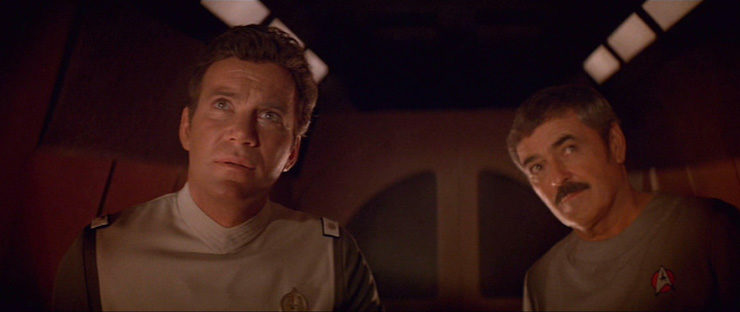
Kirk meets with Admiral Nogura, who gives him command of the Enterprise in order to intercept the swirly thing. Kirk then beams to Spacedock—the Enterprise transporters are down—and meets with Scotty (who now has a mustache). Scotty is apoplectic about the jumped-up departure time, but Kirk says that the Enterprise is the only ship in the area that can intercept the swirly thing before it reaches Earth in three days. Why the capital of the Federation has no other ships in the area is left as an exercise for the viewer.
Scotty ferries Kirk over in a shuttle, and we spend about eight hundred years on a flyby so the special effects team can show off the shiny new version of the Enterprise. (Scotty is grinning like a proud parent the entire time.) After several ice ages (really four minutes and forty-four seconds), the shuttle docks. Scotty is called to engineering and Kirk heads to the bridge.
The bridge is a mess of crazed activity, but it silences as soon as Kirk enters. Uhura (now a lieutenant commander) says they just got the change-of-command orders and she, Sulu (also a lieutenant commander), Chekov (now a lieutenant and the security chief), and the rest of the bridge crew welcome him. Kirk orders Chekov to assemble the crew at 0400 in the rec deck, and then he goes to engineering to give Decker the bad news.
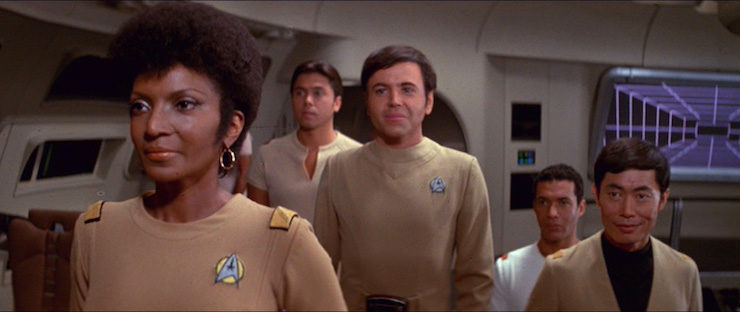
One crewmember doesn’t share in the excitement that Kirk is back in charge, asking what about Decker, who’s been with the refit from jump. Uhura snottily responds that their chances of surviving the mission just doubled, which doesn’t actually answer the crewmember’s question.
Kirk arrives in engineering, where Decker is working with Scotty. Kirk informs Decker that he’s being demoted to XO while Kirk takes command—Decker’s familiarity with the refit means he needs to stay on board. Decker is resentful—and justifiably so—but reports to the bridge as ordered.
The transporter malfunctions just as two crew members are beaming aboard. Rand (now transporter chief) tries to get them back, but they’re mangled and killed. One of the two people transporting was Sonak, so Kirk has Decker doubling as science officer, since no one else is rated on the new design.
In the rec deck, Kirk shows the crew what happened to the Klingon ships. In mid-briefing, Epsilon 9 reports that the swirly thing is two AUs in diameter, and they can’t read whatever’s at the center. The swirly thing then vaporizes Epsilon 9 the same way it destroyed the Klingon ships and continues on course.
The crew watches in horror. Kirk orders pre-launch countdown to begin in twenty minutes.
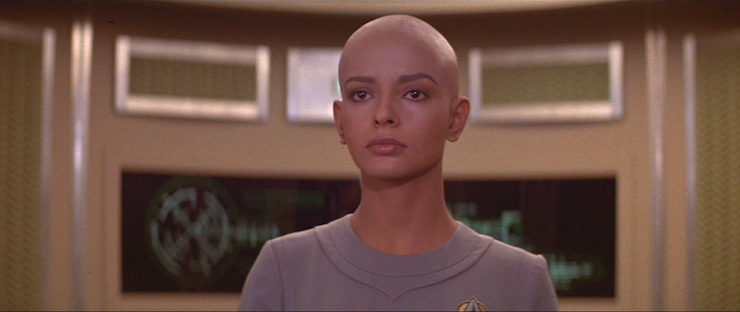
Lieutenant Ilia reports for duty. Uhura feels the need to mention that she’s Deltan. When she reports to the bridge, Decker smiles and greets her—Decker was stationed on Delta IV years earlier—and then Ilia feels the need to mention that she’s taken an oath of celibacy. Okay, then.
Uhura reports that five of the last six crew members have beamed aboard, but the sixth insists the others go first, wanting to see how it scrambles their molecules.
Rand beams McCoy aboard, in civilian clothes and a beard. He’d resigned, but Nogura drafted him with a little-used reserve activation clause—which Kirk reveals was at his request. He needs McCoy to help him deal with the swirly thing.
McCoy reluctantly comes aboard, being cranky and curmudgeonly the whole time.
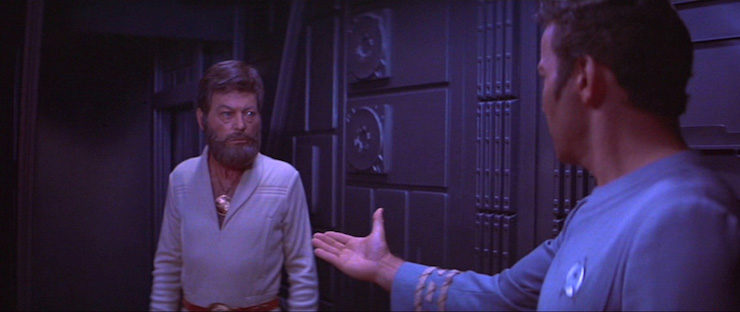
The ship takes off from Spacedock—which also takes forever, though at least we get dialogue for this—and prepares to use warp drive. Both Decker and Scotty advise further simulations. Kirk refuses at first until McCoy whups him upside the head. Once the simulation runs, Scotty’s not entirely sanguine that the untested warp engines will work.
Sure enough, the ship’s imbalanced warp drive creates a wormhole, which sucks in both the Enterprise and an asteroid that they’ll collide with. Kirk orders phasers to be armed, but Decker countermands that order, and has Chekov arm photn torpedoes and fire on the asteroid. The impact knocks them out of the wormhole and back into normal space. Systems return to normal. Leaving the conn to Sulu, Kirk orders Decker to meet with him in private.
Decker explains that phaser power is tied into warp drive, so with the warp drive offline, the phasers were also. Kirk then admits that Decker acted properly. Kirk accuses Decker of competing with Kirk, but after Decker leaves (and after the XO opines that Kirk’s inexperience with the refit ship and two-and-a-half years at a desk make him a liability) McCoy points out that Kirk’s the one competing with Decker and that Decker may be right.
A shuttlecraft rendezvouses with the Enterprise containing Spock, who took the time to get a haircut while en route from Vulcan. Kirk wastes no time restoring his commission and assigning him as science officer. Spock wastes no time fixing their engine problem and they have warp drive again—but Spock is also even less emotional than usual, sticking entirely to duty and not even providing his usual snide commentary.
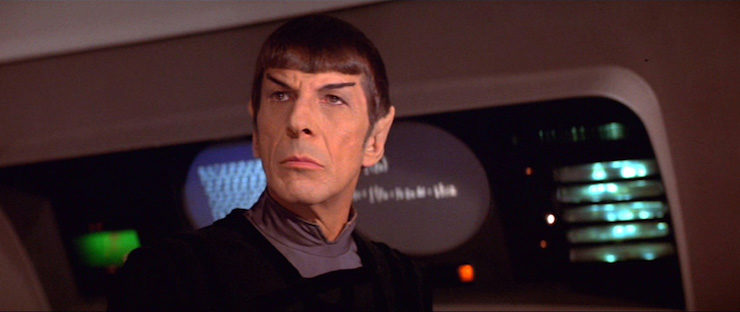
Once the ship goes to warp, Kirk meets in the lounge with Spock and McCoy, where Spock reports that he felt a powerful, and very orderly, telepathic presence from the swirly thing. He thinks it may provide the answers that Kolinahr couldn’t.
They make visual contact with the swirly thing. It scans the ship—Kirk orders Spock not to scan it in return, as that may be what prompted it to destroy Epsilon 9, nor does he arm weapons or raise shields, as that may be what prompted it to destroy the Klingons.
Spock theorizes that there is an object at the center of the swirly thing. When they reach the outer boundary, Spock senses a telepathic presence, questioning why they haven’t responded to their query. Another plasma bolt erupts, but it only overloads and damages the Enterprise—injuring Chekov in the bargain. Spock realizes that they’ve been broadcasting, but on a frequency they can’t read. Spock reprograms the computer to transmit their greetings at their frequency, which stops them from attacking again.
They hold position at the outer edge of the swirly thing. Spock advises going ahead, Decker advises caution. Kirk, unsurprisingly, goes with Spock’s recommendation and moves into the swirly thing.
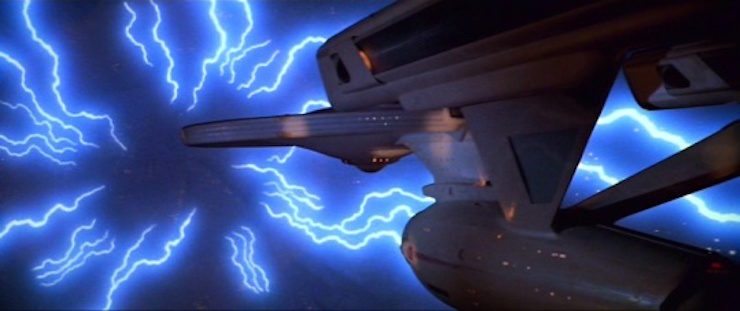
After several eternities, they finally reach the center of the swirly thing, a big blue ball. Kirk has Sulu take them on a parallel course 500 meters above the object, and then 100 meters ahead of it.
A probe arrives on the bridge in the form of a very loud shaft of light that moves around and checks out different consoles. It starts going through the ship’s computer records. Spock’s surprising solution is to physically smash the computer, which gets him zapped by the probe.
The probe examines Ilia and vaporizes her, then disappears from the bridge. The object snags the Enterprise in a tractor beam, pulling them in to the object and shutting the door behind them. Once inside, the tractor beam is released.
Kirk orders Sulu to move forward and Spock to scan ahead. However, all scans are reflected right back. Chekov reports an intruder alert in Ilia’s quarters. Kirk, Spock, and a security guard arrive to find an automaton that has taken on Ilia’s form. It’s a probe programmed by something called V’Ger to observe the carbon-based life-forms that have infested the Enterprise. However, the probe recognizes Decker, so Kirk has Decker be the one to show the probe around the ship in the hopes that the probe has duplicated her memories so precisely that her feelings for Decker are in there somewhere.
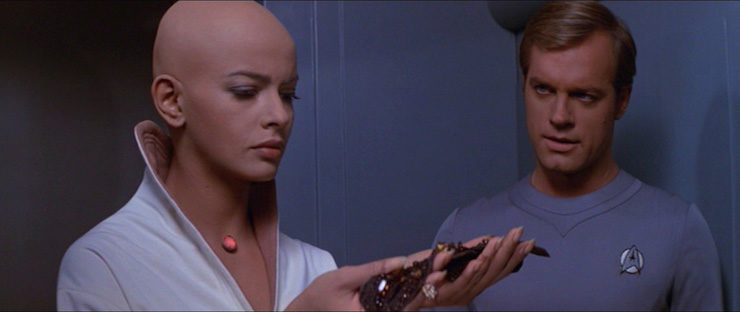
To that end, Decker takes her to the recreation deck and shows her a game Ilia enjoyed. For a moment, there is a flicker of recognition, but then the probe declares that the game serves no purpose, and moves on. The probe is confused as to why the Enterprise has so many carbon units on board, and also reveals that carbon units are broken down into pattern storage when they’re vaporized. Decker offers to bring Ilia’s memories to the fore to help the probe understand the carbon units better.
The probe also informs Decker that—while V’Ger is searching for its creator, V’Ger doesn’t actually know who that is.
Spock steals a thruster suit—assaulting a crew member with a neck pinch in the process—and heads into the heart of V’Ger. It looks like a representation of V’Ger’s homeworld, and then images of planets, moons, galaxies, even Epsilon 9 and Ilia—stored images of V’Ger’s entire journey. Spock is now convinced that they are inside a living machine.
He tries to mind-meld with it, and is electrocuted for his trouble.
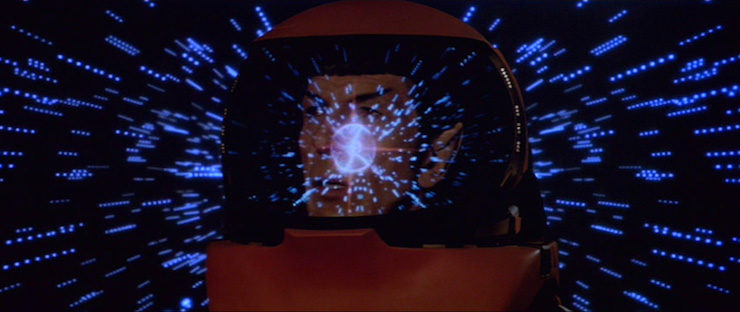
Kirk goes out in a thruster suit of his own, just as Spock is ejected by V’Ger. Kirk catches him and brings him to sickbay. Spock finally shows emotion, calling Kirk “Jim” for the first time, and almost smiling. He realizes that V’Ger is indeed pure logic with no emotion—and that leaves V’Ger empty with no answers to questions it cannot help asking.
V’Ger is now in orbit of Earth and sending out a signal looking for its creator. The signal is an old-fashioned radio signal, and when there’s no response, V’Ger deactivates Earth’s entire defense and communications grid. It sends out probes to equidistant points in orbit of Earth, which then reproduce to surround the planet completely.
The probe says that V’Ger will wipe out the carbon infestation of the creator’s homeworld. After Spock hypothesizes that V’Ger is akin to a child, Kirk announces that he knows why the creator isn’t responding but he won’t disclose it until the probes are removed from Earth orbit, and he will only disclose it to V’Ger directly, not its probe.
In response, V’Ger hits the Enterprise with another tractor beam. In response to that, Kirk orders Scotty to set the Enterprise to self-destruct on his order, as a last-ditch tactic to destroy V’Ger.
Spock is actually crying, sad for V’Ger, who is where he was when he attempted Kolinahr. It is asking questions about its purpose in life, seeking out its creator for the great answers to life, the universe, and everything, and not being told that it’s 42.
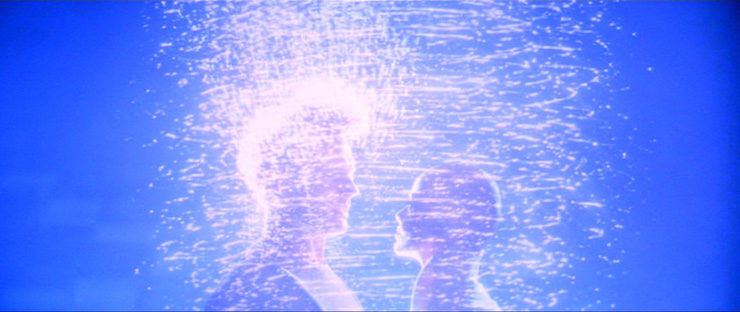
Uhura pinpoints the source of the transmission, and the probe leads Kirk, Spock, McCoy, and Decker to the hull of the saucer section. V’Ger has created an Earth-like atmosphere and a walkway to its center—which turns out to be the sixth of the Voyager probes, sent out from Earth in the late 20th century. It fell into a black hole and came out on the other side of the galaxy and was found by the machine planet. It saw Voyager 6 as a life form, and upgraded it so it could perform its programming—to collect data and report that information to its creator on Earth.
But it’s now three hundred years late, and nobody on Earth is left who worked on Voyager 6. Kirk contacts Uhura and asks her to call up the NASA code response for Voyager 6 and transmit it.
However, it doesn’t work. The probe insists that the creator must join with V’Ger. Decker volunteers to join with V’Ger as a representative of its human creator. Decker becomes part of V’Ger, at which point V’Ger goes cosmic.
Kirk tells Uhura to list Decker and Ilia as missing rather than as casualties, and then tells Scotty that it’s time for a proper shakedown cruise. He orders Sulu to go ahead warp one, and away they go.
The human adventure is just beginning…
Can’t we just reverse the polarity? V’Ger’s plasma weapons don’t just vaporize their targets, but scan them thoroughly and break them down into information, as Spock discovers when he sees Epsilon 9, dozens of planets, and Ilia in the heart of V’Ger. Oddly, he doesn’t see any of the Klingons.
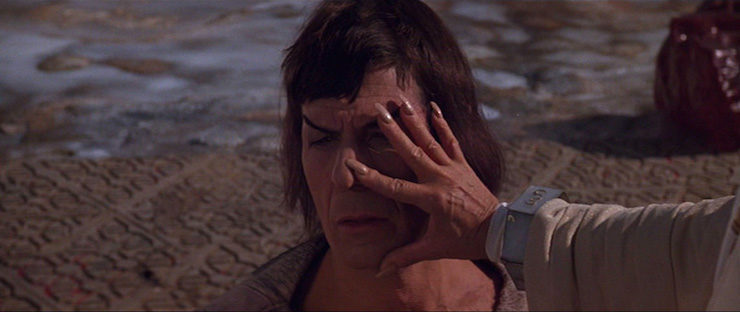
Fascinating. Spock resigned after the five-year mission and returned to Vulcan. His attempt to completely eliminate emotions from his life via Kolinahr fails because of telepathic contact with V’Ger—which ultimately makes him realize that a life without emotion is hollow and fruitless.
He continues his streak of horrible behavior without consequences (“The Menagerie,” “Operation: Annihilate,” “Amok Time,” etc.), as he assaults a fellow crew member and takes a thruster suit without authorization.
I’m a doctor not an escalator. McCoy also resigned after the five-year mission, but is activated by Kirk. He serves his usual function of kicking Kirk in the ass when he needs it—though there are several occasions where he wanders onto the bridge, watches what’s happening, and then just leaves without a word.
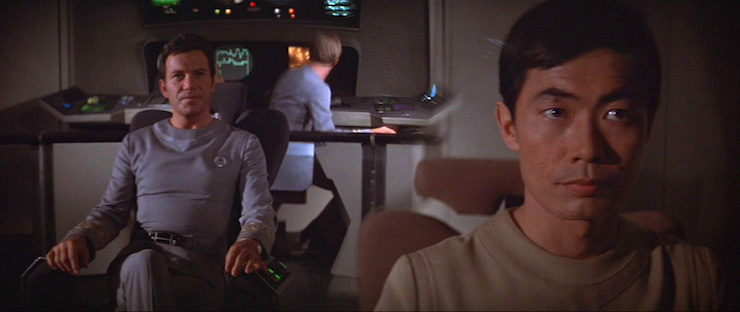
Ahead warp one, aye. Sulu is still flying the ship. He’s also third in command behind Kirk and Decker (Spock is only reinstalled as science officer, so he’s not in the chain of command, not that it comes up), and it’s implied that he was Decker’s first officer, though that’s not confirmed.
Hailing frequencies open. Uhura does her usual opening of hailing frequencies and such, in particular coordinating with Starfleet Command.
I cannot change the laws of physics! Scotty has to nurse the brand-new engines through an ad-hoc shakedown, though it’s Spock who actually fixes the biggest problem.
It’s a Russian invention. Chekov is now chief of security and tactical officer. He also gets to scream when his console exploding burns his arm and also has the funniest non-McCoy line of the movie. When Decker tells him not to interfere with the probe (right before it kills Ilia), Chekov stares nervously at it and cries, “Absolutely, I will not interfere!”
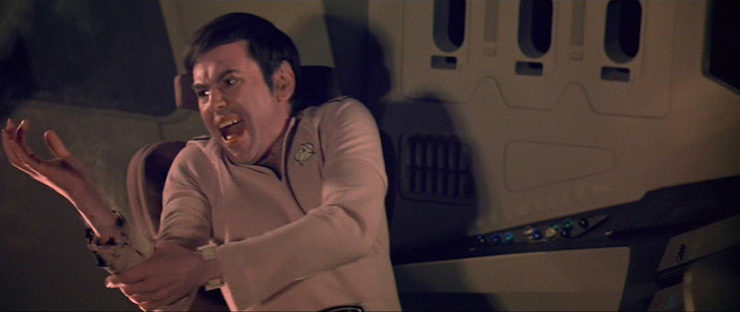
Go put on a red shirt. Only four crew members die, and none of them are security, amazingly enough: Sonak and another person (I suppose she could’ve been security…) in the transporter malfunction, Ilia from the probe, and Decker sacrificing himself to transform V’Ger.
No sex, please, we’re Starfleet. Decker and Ilia have a past from his time serving on Delta IV. When the probe arrives on board looking like Ilia, she’s in the shower and nude, so Kirk puts, not a uniform or simple civilian clothes, but a revealing sexy bathrobe on her. Sure.
Deltans have a very strong sex drive, and she has a goofy-inducing effect on the male members of the crew similar to that of “Mudd’s Women,” though this is natural rather than artificial. (Notably, this aspect of Ilia’s character is heavily downplayed in the director’s cut.)
Channel open.
“Why is any object we don’t understand always called a ‘thing’?”
–McCoy, being cranky-yet-insightful.
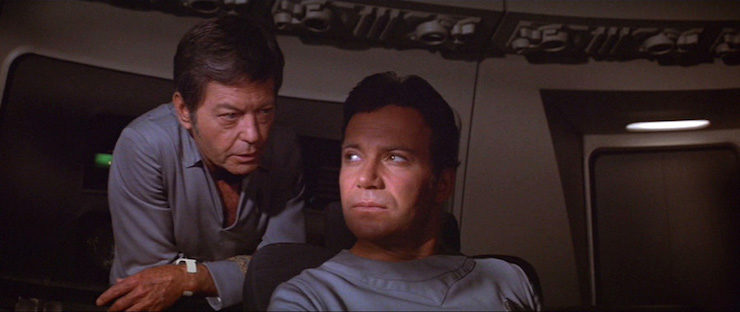
Welcome aboard. Besides the big three returning, we’ve got James Doohan, Nichelle Nichols, George Takei, Walter Koenig, Majel Barrett, and Grace Lee Whitney back in their familiar roles. Doohan, Nichols, Takei, and Barrett were last seen in the animated series, while Koenig was last seen in “Turnabout Intruder” and Whitney was last seen in “The Conscience of the King.” Persis Khambatta and Stephen Collins are the big “guests,” playing Ilia and Decker, respectively. It was one of Khambatta’s first American roles, and she was billed, “Presenting Persis Khambatta,” making it look like her coming-out party in American film, even though it was not her first role.
Mark Lenard achieves a trifecta by appearing as the Klingon captain in the opening sequence, having previously played a Romulan (“Balance of Terror“) and a Vulcan (“Journey to Babel,” “Yesteryear“). He’ll next be seen in The Search for Spock, reprising the role of Sarek.
In addition, David Gautreaux—who was set to play Xon in Phase II (see below)—gets a make-good by being cast as the commander of Epsilon 9. Marcy Lafferty (William Shatner’s wife at the time of filming) plays DiFalco, Ilia’s replacement at navigation, Jon Rashad Kamal plays the ill-fated Sonak, and Edna Glover plays the Vulcan who refuses to grant Spock Kolinahr.
Trivial matters: By the mid-1970s, Paramount had obtained all the assets of Desilu Studios, the production company that owned Star Trek. Paramount was considering starting a fourth network, with Star Trek: Phase II as its flagship. That plan wound up being abandoned, though several scripts had been commissioned. Two of them were rewritten into TNG episodes—”The Child” and “Devil’s Due“—and the pilot, “In Thy Image,” was repurposed into the script for the movie that Paramount decided to do instead. In 1995, Paramount again decided to form a network and use a Star Trek show as its flagship, with the United Paramount Network debuting with Voyager‘s “Caretaker” in January of that year. UPN only lasted eleven years before it was merged with the WB to form the CW.
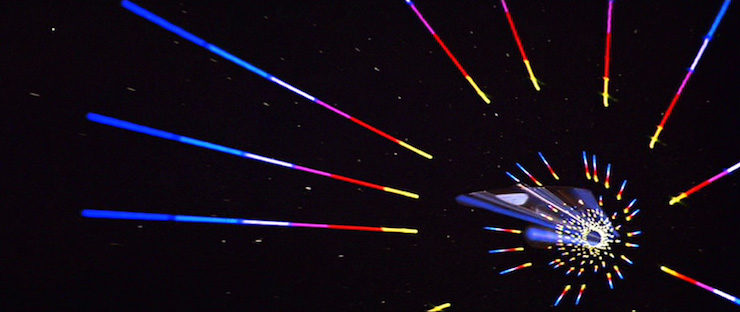
Roddenberry was contracted to do a Star Trek movie with Paramount going back to 1974, though all of his story notions, and those of other writers commissioned by Roddenberry and by Paramount were rejected. The success of Star Wars led to rethinking it as a TV series, which led to Phase II, but then they circled back around to a movie when Paramount pulled the plug on a network, as they’d already spent a bunch of money to set up a TV production, which was then transferred to the movie budget.
Leonard Nimoy was the only main cast member to decline to appear in Phase II. His spot on the crew was taken over by two people: Decker as first officer and a full-blooded Vulcan named Xon as science officer. Ilia was also to be the new navigator. However, Nimoy was willing to appear in the feature film, so Xon was written out (replaced with Sonak, who was quickly dispatched in a transporter accident), and both Decker and Ilia didn’t survive the end of the film, either, thus putting the band back together without any yucky outsiders.
This movie famously went horribly overbudget, partly due to constant script rewrites, mostly due to Robert Abel & Associates, the original special effects house, shitting the bed and having to be replaced by Douglas Trumbull, who had to redo the effects from scratch.
This is the first time the Earth of the 23rd century has been seen. All but two subsequent movies will feature at least some scenes on Earth, the exceptions being Star Trek Insurrection and Star Trek Beyond.
We hear both the Klingon and Vulcan languages for the first time, the former developed by James Doohan, the latter by linguist Hartmut Scharfe. Both languages would be re-done by linguist Marc Okrand in the next two movies. In addition, we also see “bumpy-headed” Klingons for the first time. The differences between these and the more human-looking Klingons seen in the original series was left unspoken and unexplained for years, until the 2005 Enterprise episodes “Affliction” and “Divergence.”
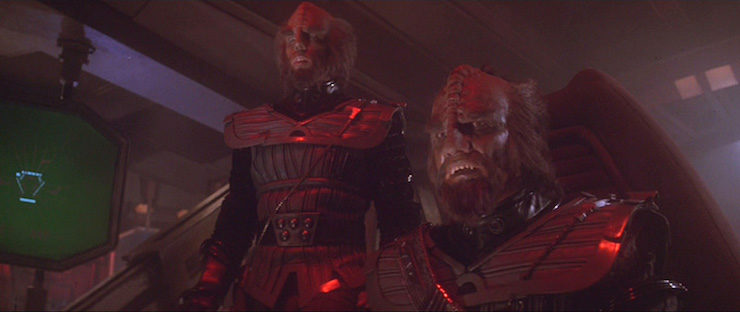
The novelization of this film was written by Gene Roddenberry his own self, his first (and only) novel credit. It kicked off Simon & Schuster taking over the license for Trek novels from Bantam Books, and S&S continues to publish Star Trek novels to this day.
The comic book adaptation of the film kicked off Marvel’s acquisition of the license as well, with the first three issues of their monthly Star Trek comic being an adaptation of the film by Marv Wolfman, Dave Cockrum, & Klaus Janson. However, Marvel’s first run would only last eighteen issues before they let the license lapse. In addition, a newspaper strip was launched concurrently with the film, which lasted until 1983.
The period between the end of the five-year mission and this movie was initially chronicled in the novel The Lost Years by J.M. Dillard, and several subsequent stories were published under the “Lost Years” banner to indicate being in that two-and-a-half-year timeframe.
Decker was spotlighted in the Enterprise Logs story “Night Whispers” by Diane Duane, and also fleshed out in the novel Ex Machina by Christopher L. Bennett. The latter novel was explicitly written as a direct sequel to this film, fleshing out the situation before and after the movie and also much of the new crew, seen mostly just as background extras. Among Decker’s other appearances: the DC comic Star Trek Annual #2 by Mike W. Barr, Dan Jurgens, & Bob Smith, and your humble rewatcher’s The Brave and the Bold Book 1.
While it’s never stated in the film, it was always intended (and all the tie-in fiction, particularly Roddenberry’s novelization of the film, have gone with this) for Decker to be the son of Matt Decker, the ill-fated Constellation commanding officer from “The Doomsday Machine.”
All the characters who remained in Starfleet have been promoted since the end of the series: Kirk is an admiral, Scotty is a full commander, Sulu and Uhura are lieutenant commanders, and Chekov is a lieutenant. Chapel has achieved her MD, and Rand is now transporter chief.
DiFalco, the replacement navigator, was a supporting character throughout Marvel’s first run of comics.
The backstory for Decker and Ilia was repurposed (almost word for word) as the backstory for Riker and Troi in TNG.
The redesign of the Enterprise would continue to be the template for Starfleet ship designs in each of the spinoff TV series—even the prequel. The bridge of the Klingon ship is also the template for every Klingon bridge seen since.
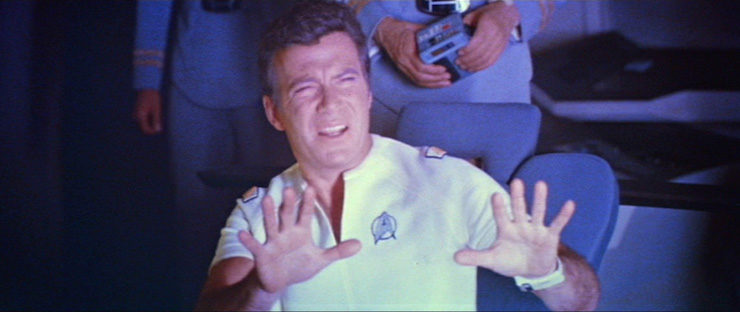
To boldly go. “Out there—thataway.” The Motion Picture was released in 1979. I was ten years old, and I absolutely loved it. Looking back, I’d say there were two reasons why I loved it: (1) After spending literally my entire life watching the original series episodes over and over again every weeknight at 6pm (and rereading James Blish‘s adaptations of same over and over again), I was really really really ready for new Trek. (2) I was ten.
As I grew older, I began to see the flaws, and came to intensely dislike the film. The acting is uniformly horrible, the visuals are bloated and overused, the story is not actually that interesting (and more than a little derivative of “The Changeling“), and the pacing is abominable.
Watching it now is notable, also for two reasons. (1) I haven’t actually watched it in ages. (2) I finally watched the director’s cut, which numerous apologists for this piece of garbage have said I should watch because it’s so much better. I was skeptical of #2 because no amount of reediting can fix the bad story or the bad acting.
And I was right. The director’s cut is better than the theatrical cut, yes, but only in the way that one root canal is better than three root canals.
The pacing in this movie is just a total disaster, even reedited by Robert Wise. The biggest offender, as I said above, is Kirk and Scotty’s flyby of the refurbished Enterprise. Twenty-five years ago on The Chronic Rift, a public access talk show I cohosted, I referred to that scene as “the long, masturbatory look at the new Enterprise,” and I stand by that description. Four minutes and forty-four fucking seconds we have to endure Kirk’s “ooh shiny” moment.
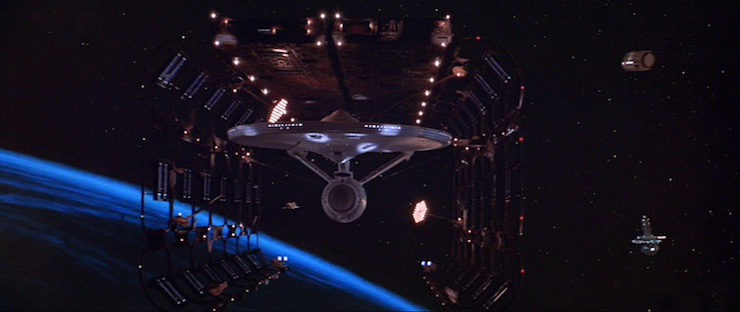
And while it’s the worst offender, it’s hardly the only one. Every special effects-heavy scene takes longer than it should, from the launch out of Spacedock to the excursion through the wormhole—which has all the suspense drained out of it by the time Chekov finally fires the torpedo—to the trip through the swirly thing to the heart of V’Ger.
Watching this immediately after finishing the original and animated series is very much like watching a Zack Snyder DC Comics film right after reading a comic book—it feels like all the color has been drained from everything. The movie is all grays and blues. Even the white of the engineering suits and the short-sleeved uniforms feels muted.
Thank goodness DeForest Kelley is in this movie, because it would be unbearable otherwise. His acid tongue and snide remarks are the only relief from the endless stilted line readings. With Spock, this works, as he’s going for totally emotionless, but Nimoy also doesn’t stand out very much because everyone else sounds like that, too. Bits of personality occasionally bleed through in the regulars, but the secondary actors—from the Epsilon 9 crew to DiFalco to the guy who wondered how Decker would feel about being kicked out of the center seat to the other engineers working with Scotty—all sound like bored high school students reading off cue cards. Even Mark Lenard—slathered in latex and speaking a made-up language—can’t do anything with his Klingon captain.
Not that that character even belongs there. The entire sequence with the Klingons is emblematic of the “hey, look, we have money, now!!!!” aesthetic of the movie. Either that or, “Dammit, we paid for these effects, and we’re gonna use them!” The Klingons serve precisely zero function in the story. The swirly thing could have just gone straight at Epsilon 9 and saved us the first of many long, uninteresting effects sequences, and they could have saved the new Klingon design for when they’re actually part of the plot two movies hence. As it is, they just show up, fire on the swirly thing, and get vaporized, and then are never mentioned again. Spock doesn’t even see them in his fly-through of V’Ger.
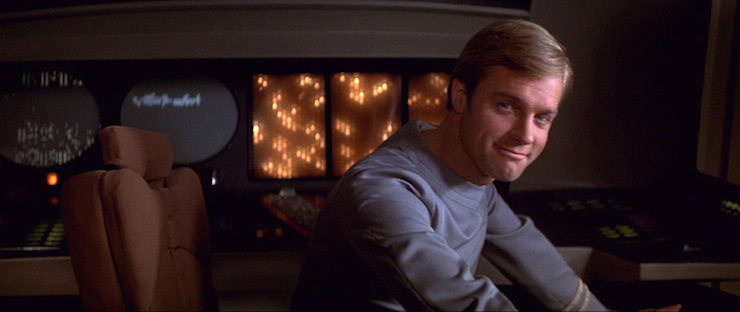
Another character that might have been better served not in the story is Decker. Apparently, removing the character was an option that was discussed once Nimoy joined the cast, as Decker was only created to take over as first officer because there would be no Spock. As it is, leaving Decker in there only serves to make the lead look like a dick.
Seriously, we all just assume that Kirk should be in the center seat because that was where we saw him for three seasons in live-action and two more in animation, and he’s The Shat and that’s where he belongs. But watching the movie now, I was struck by how much of an asshole he is in this film. He’s been promoted—which is what happens to successful captains—and the person he recommended for the job of replacing him is in place as captain of a ship that’s barely even recognizable as the same vessel anymore. Yet he basically bullies his way into the center seat, and while Uhura and Sulu and Chekov seem thrilled, and Scotty is more guardedly optimistic, the fact of the matter is that I’m on the side of that crewmember who felt the need to point out that the Enterprise already had a captain.
Sure, it’s possible that Decker wouldn’t have done as good a job with V’Ger as Kirk did, but while the options he suggested weren’t always the right ones, he was, by his own admission, providing alternatives in his position as first officer. As captain, he might have done something different.
Plus, of course, if Kirk had followed his advice, maybe Ilia wouldn’t have been vaporized.
The only thing I actually found myself liking and appreciating more in this movie upon rewatching it for the first time in so long is how important this movie is for the character of Spock. It was a bear to get Nimoy back for the film, as various issues kept him from wanting to return to the character he wrote an entire autobiography to disassociate himself from (I Am Not Spock). But ultimately, he’s the character best served by the movie (even as Kirk is the worst), as exposure to V’Ger and its longing for emotions it can’t feel makes him realize that his two heritages shouldn’t be at war with each other, as he himself described it in “The Enemy Within” and felt writ large in “The Naked Time.” Instead, he realizes that he can and should find a balance between logic and emotion. The catharsis Spock undergoes here is reflected in his subsequent appearances as Spock in the future movies, as well as on TNG.
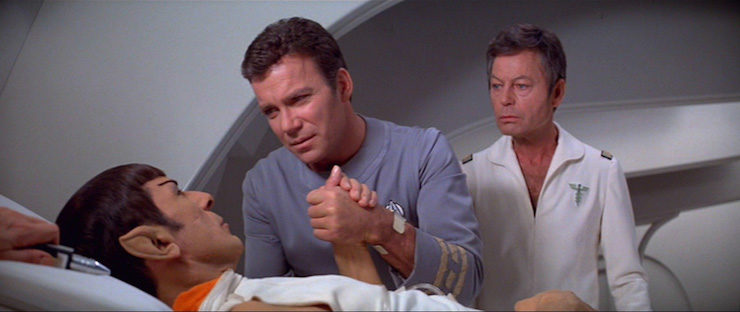
The number of derisive nicknames this movie has received are legion: The Motionless Picture, The Motion Sickness, Where Nomad Has Gone Before, and so on. And they’re all deserved. The character arc for Spock and the very presence of McCoy’s glorious snark leaven it considerably, but overall this is a tiresome slog of a movie that spends far too much time being a spectacle and not enough time actually telling its story, and when it does do the latter, it does so poorly and woodenly.
In that way, at least, it sets the tone for every other Trek movie, which is a thirteen-movie litany of spectacle over substance.
Warp factor rating: 2
Next week: Star Trek: The Wrath of Khan
Keith R.A. DeCandido has two works coming out this month: the novel Marvel’s Warriors Three: Godhood’s End, Book 3 of the “Tales of Asgard” trilogy, available for preorder from Joe Books; and the short story “Behind the Wheel” in TV Gods: Summer Programming, which will launch at Balticon 51 over Memorial Day weekend from Fortress Publishing.










